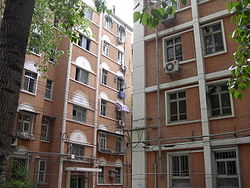Hepingli Subdistrict
和平里街道 | |
|---|---|
 Residential blocks in Hepingli, 2003 | |
 Location of Hepingli Subdistrict within
Dongcheng District | |
| Coordinates: 39°57′14″N 116°25′20″E / 39.95389°N 116.42222°E 39°57′14″N 116°25′20″E / 39.9539°N 116.4221°E | |
| Country | China |
| Municipality | Beijing |
| District | Dongcheng |
| Area | |
| • Total | 5.02 km2 (1.94 sq mi) |
| Population (2020) | |
| • Total | 102,227 |
| • Density | 20,000/km2 (53,000/sq mi) |
| Time zone | UTC+8 ( China Standard) |
| Postal code | 100013 |
| Area code | 010 |
Hepingli Subdistrict ( Chinese: 和平里街道; pinyin: hépínglǐ jiēdào) is a residential neighborhood and a subdistrict of Dongcheng District, Beijing. It is situated in the northeastern part of the city between the northern 2nd Ring Road and the northern 3rd Ring Road. The neighborhood is bordered by Andingmen Waidajie to the west and Hepingli Dongjie to the east.
Hepingli has 102,227 residents in 2020, [1] and comprises 20 residential areas (社区) or zones. Most apartment buildings were built in the 1950s to 1960s. In the early 2000s, most buildings were repainted.
History and Name
Heplingli, meaning “a place of peace”, was named in 1952 during the Asia and Pacific Rim Peace Conference which was held in Beijing. [2]
Below is a table summarizing the changes in the administrative status of the land within Hepingli: [3]
| Year | Status |
|---|---|
| 1912 | Part of North Suburban District |
| 1949 | Part of Dongcheng District. Two street governments were formed: Andingmenwai Dajie Yijie and Andingmenwai Dajie Erjie |
| 1952 | The two were merged to create Andingmenwai Dajie Street Government |
| 1953 | Street Government was changed to Street Office |
| 1955 | Redrawn to two subdistricts: Anwai Zhazipo and Hepingli |
| 1958 | Merged into Hepingli Subdistrict |
| 1960 | Changed to a commune |
| 1990 | Reverted back to a subdistrict |
Administrative Division
As of 2021, there are 20 communities within the subdistrict: [4]
| Administrative Division Code | Community Name in English | Community Name in Simplified Chinese |
|---|---|---|
| 110101010003 | Minwang | 民旺 |
| 110101010008 | Andelu | 安德路 |
| 110101010009 | Erqu | 二区 |
| 110101010011 | Qiqu | 七区 |
| 110101010013 | Huagong | 化工 |
| 110101010014 | Andeli | 安德里 |
| 110101010015 | Xinghua | 兴化 |
| 110101010016 | Rendinghu | 人定湖 |
| 110101010017 | Xiaohuangzhuang | 小黄庄 |
| 110101010018 | Zongzheng | 总政 |
| 110101010019 | Anzhenyuan | 安贞苑 |
| 110101010020 | Ditan | 地坛 |
| 110101010021 | Huangsi | 黄寺 |
| 110101010022 | Xinjianlu | 新建路 |
| 110101010023 | Dongheyan | 东河沿 |
| 110101010024 | Xiheyan | 西河沿 |
| 110101010026 | Qingnianhu | 青年湖 |
| 110101010027 | Hepingli | 和平里 |
| 110101010028 | Jiaolin | 交林 |
| 110101010029 | Shanglong | 上龙 |
Transportation
Hepingli is served by Lines 5 and 13 of the Beijing Subway. Line 5 traverses the neighborhood from north to south with stops at Heping West Bridge and Hepingli Beijie. Line 13 stops near eastern Hepingli at Liufang.
Main city bus routes through Hepingli include 13, 18, 62, 75, 104, 108, 116, 117, 119, 124, 125, 127, 407, 430, and 特16.
The Heping West and East Bridges on the 3rd Ring Road are named after Heplingli. The Hepingli Railway Station was replaced by the Liufang Station of the Line 13. The area has an expressway link—the Jingcheng Expressway connects to Hepingli at Taiyanggong Bridge.[ citation needed]
Landmarks
See also
External links
References
-
^
Zhong guo tong ji nian jian = China statistical yearbook. 2020(zong di 39 qi) 2020(No. 39). Guo jia tong ji ju, 国家统计局. (Di 1 ban ed.). Beijing: Zhong guo tong ji chu ban she. 2020.
ISBN
978-7-5037-9225-0.
OCLC
1262741013.
{{ cite book}}: CS1 maint: others ( link) - ^ (Chinese) 昔和平里(图) 京报网 Archived 2011-07-20 at the Wayback Machine 2010-04-12
-
^
Zhong hua ren min gong he guo zheng qu da dian. Bei jing shi juan. Li li guo, Li wan jun, Wu shi min, 李立国., 李万钧., 吴世民. Bei jing: Zhong guo she hui chu ban she. 2013.
ISBN
978-7-5087-4058-4.
OCLC
910451741.
{{ cite book}}: CS1 maint: others ( link) - ^ "2021年统计用区划代码和城乡划分代码". www.stats.gov.cn. Retrieved 2022-09-18.

